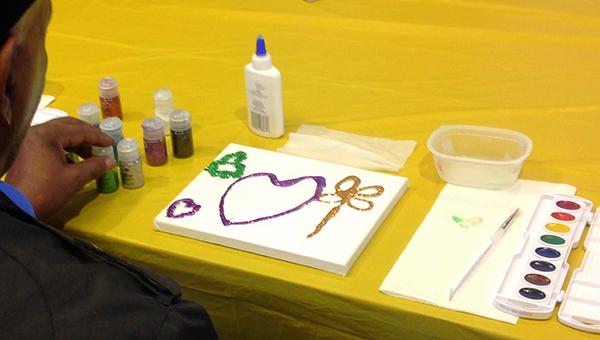When Potts’ parents moved to Tuscaloosa in 2000, his father took a job parking cars and started to forget where he had parked the cars and often locked the keys in them. Sometimes he would get lost on the parking deck and not know where he was. It was then Potts thought his father might have Alzheimer’s disease.
“I think I was in denial, or perhaps I just didn’t want to see it,” Potts said. “So that’s been a source of guilt for me as his child and as a neurologist to not be aggressive enough to intervene early on.”
Once Potts’ father had progressed into the disease and could not stay at home all day, the family said they decided it would be best to take him to the Caring Days adult day care center in Tuscaloosa. It was there that Potts’ father was introduced to art therapy.
Potts said he was amazed by the watercolor paintings his father had made. Through painting, his father’s memory, mood and cognition appeared to improve.
Potts began to write poetry and eventually started putting together a book titled “The Broken Jar,” a collection of his father’s art and his poetry. When the book was finished, Potts gave the book to the Caring Days facility. After his father passed away, Potts said he knew he had to do something, so he and his family started the Cognitive Dynamics Foundation.
“We started Cognitive Dynamics, which is a foundation that’s about improving quality of life through the arts,” Potts said. “Shortly after we did that I came to admit with Dr. Jacqueline Morgan, wanting to see how we might involve the Honors College in an educational experience with this. We knew we wanted to combine art therapy, life story and education, and knowing Dr. Morgan, she said, ‘Let’s find a way to do this.’”
The Art to Life program gives students a chance to interact with participants who have Alzheimer’s. Jacquelynn Myrick, a junior majoring in psychology, is the current student facilitator of the program.
The class has two parts: a lecture that introduces the students to the story behind Art to Life and how the disease itself works and a lab where the students are divided into groups to work with participants.
Myrick said one of her favorite memories in the program is working with a woman who shared her Hispanic heritage and love of dancing.
“Our art therapist, Karen Gibbons, brought in some music and started playing the Cha Cha,” Myrick said. “The next thing I know, Dr. Potts looks over at Ms. Jackie and asked her if she wants to dance. She stood up in art therapy with the biggest joy and the most laughter and starts dancing with Dr. Potts and teaching the rest of us how to dance.”
Myrick said when the patients paint, it invokes more of an emotional memory than a specific one. The program has almost finished writing a manual for other educational institutions that want to adopt the program and get students involved with art therapy.
Potts said the program has not only transformed his life and the lives of his students, but the participants’ lives as well.
“We had one woman who used to be a former artist and had macular degeneration,” Potts said. “She couldn’t see her art. So the art therapist said, ‘We’re going to show all of our students your art and let them tell you what they think of it.’ We went around the room and all of the students described the art, so then the art therapist said, ‘So what do you think about this now?’ She, in tears, said, ‘There’s something there – a new beginning. You’ve given me my life back. I never thought I would feel colors again.’”









